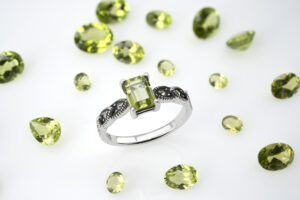The peridot gemstone is one of nature’s most fascinating creations — a gem that embodies the warmth of the sun and the beauty of the earth. Its luminous green glow has captivated jewelry lovers for thousands of years. But beyond its beauty lies an equally intriguing origin story that connects peridot to both volcanic fire and cosmic wonder. In this article, we’ll explore the natural origins of the Peridot Gemstone, how it forms, and why it continues to shine as one of the most unique gemstones in the world. mood ring color meanings
What Makes the Peridot Gemstone Special

Before understanding its origins, it’s worth appreciating what makes peridot so exceptional. This gem is the only one that occurs in just one color — a distinctive green that ranges from pale lime to deep olive, depending on its iron content. Unlike many gemstones that get their color from impurities, peridot’s hue is natural and consistent, giving it a vivid, refreshing appearance that symbolizes harmony and renewal.
Peridot is the birthstone for August and is often associated with positive energy, good fortune, and emotional balance. Its bright tone and natural clarity make it a popular choice for rings, pendants, and fine jewelry.
Peridot Gemstone: Born from the Depths of the Earth
The Peridot Gemstone originates deep within the Earth’s mantle — approximately 20 to 55 miles below the surface. It forms under extreme heat and pressure in the molten rock layer, where the mineral olivine crystallizes over millions of years. When volcanic activity pushes this molten material toward the surface, peridot crystals are brought up through lava flows or volcanic eruptions.
This fiery origin gives peridot its nickname, “the gem born of fire.” It’s one of the few gemstones that can form both in volcanic and extraterrestrial environments, making it a geological marvel.
-
Volcanic Formation
Most peridot found on Earth comes from volcanic rocks called basalts. These rocks contain high amounts of magnesium and iron — the key elements that give peridot its green hue. When lava cools rapidly after eruption, small crystals of peridot form inside, sometimes large enough to be mined as gemstones.
Some of the most famous peridot deposits are found in Hawaii, Myanmar (Burma), China, and Pakistan. In fact, the green sands of Hawaii’s Papakōlea Beach get their color from tiny fragments of olivine, the same mineral that forms peridot.
-
Extraterrestrial Origins
Peridot isn’t just an earthly treasure — it also comes from space. Scientists have discovered peridot crystals in meteorites known as pallasites, which are remnants of ancient asteroids. These extraterrestrial peridots formed billions of years ago, providing a direct connection to the formation of our solar system. Some of these space-born gems are displayed in museums as cosmic wonders.
The Global Sources of Peridot
Today, peridot is mined in several parts of the world, each producing gems with unique qualities.
- Myanmar (Burma): Known for producing some of the finest and largest peridot gemstones, with rich green tones and exceptional clarity.
- Pakistan: The Kashmir region yields high-quality peridots with deep green hues and minimal inclusions.
- China: One of the largest producers of commercial-grade peridot used in modern jewelry.
- United States (Arizona and Hawaii): Arizona’s San Carlos Apache Reservation is one of the most significant peridot mining locations, supplying much of the world’s gem-quality stones.
These regions continue to supply peridot to global jewelry markets, including Thailand — a major hub for gemstone cutting and jewelry craftsmanship.
The Connection Between Peridot and Olivine

Peridot is the gem-quality variety of olivine, a common mineral found in the Earth’s upper mantle. While olivine is abundant, gem-quality peridot is rare. The gem must form under precise conditions — high temperature, pressure, and a specific chemical balance. That’s why fine peridots are treasured for their rarity and brilliance.
Interestingly, peridot is one of the few gemstones that can occur both on Earth and in outer space, making it a bridge between planetary geology and cosmic history.
Symbolism and Cultural Significance
Across cultures, peridot has been cherished for its protective and spiritual qualities. Ancient Egyptians called it the “gem of the sun” and believed it could ward off evil spirits. Medieval Europeans saw it as a stone of healing and friendship. In modern times, peridot continues to symbolize growth, renewal, and harmony — qualities that make it a favorite choice for jewelry and personal adornment.
Caring for Peridot Jewelry
While peridot is durable enough for everyday wear, it should be handled with care. Here are some tips to preserve its brilliance:
- Clean with warm water and mild soap using a soft brush.
- Avoid exposure to harsh chemicals, acids, or ultrasonic cleaners.
- Store separately from harder stones like sapphires or diamonds to prevent scratching.
Proper care ensures your peridot jewelry retains its glow and clarity for generations.
Thailand’s Role in the Peridot Gemstone Industry
Thailand has earned a global reputation for excellence in gemstone craftsmanship. Thai jewelry makers skillfully cut and set peridot stones into beautiful rings, earrings, and pendants. With advanced techniques, ethical sourcing, and exquisite artistry, Thailand has become a major exporter of Peridot Gemstone jewelry to international markets.
The Peridot Gemstone is a true marvel of nature — a gem forged in the heart of the Earth and occasionally delivered from the stars. Its brilliant green color and uplifting energy make it a timeless symbol of renewal and positivity. Whether you admire it for its geological wonder, historical significance, or spiritual meaning, peridot remains one of the world’s most extraordinary gemstones — a radiant reminder of the power and beauty of nature itself.
